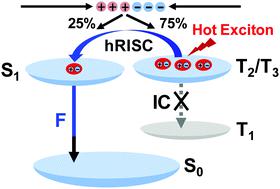当前位置:
X-MOL 学术
›
Chem. Soc. Rev.
›
论文详情
Our official English website, www.x-mol.net, welcomes your feedback! (Note: you will need to create a separate account there.)
Recent progress in hot exciton materials for organic light-emitting diodes
Chemical Society Reviews ( IF 46.2 ) Pub Date : 2020-11-24 , DOI: 10.1039/d0cs00391c Yuwei Xu 1, 2, 3, 4, 5 , Pei Xu 1, 2, 3, 4, 5 , Dehua Hu 1, 2, 3, 4, 5 , Yuguang Ma 1, 2, 3, 4, 5
Chemical Society Reviews ( IF 46.2 ) Pub Date : 2020-11-24 , DOI: 10.1039/d0cs00391c Yuwei Xu 1, 2, 3, 4, 5 , Pei Xu 1, 2, 3, 4, 5 , Dehua Hu 1, 2, 3, 4, 5 , Yuguang Ma 1, 2, 3, 4, 5
Affiliation

|
According to Kasha's rule, high-lying excited states usually have little effect on fluorescence. However, in some molecular systems, the high-lying excited states partly or even mainly contribute to the photophysical properties, especially in the process of harvesting triplet excitons in organic electroluminescent devices. In the current review, we focus on a type of organic light-emitting diode (OLED) materials called “hot exciton” materials, which can effectively harness the non-radiative triplet excitons via reverse intersystem crossing (RISC) from high-lying triplet states to singlet states (Tn → Sm; n ≥ 2, m ≥ 1). Since Ma and Yang proposed the hot exciton mechanism for OLED material design in 2012, there have been many reports aiming at the design and synthesis of novel hot exciton luminogens. Herein, we present a comprehensive review of the recent progress in hot exciton materials. The developments of the hot exciton mechanism are reviewed, the fundamental principles regarding molecular design are discussed, and representative reported hot exciton luminogens are summarized and analyzed, along with their structure–property relationships and OLED applications.
中文翻译:

用于有机发光二极管的热激子材料的最新进展
根据卡沙定律,高激发态通常对荧光几乎没有影响。但是,在某些分子系统中,高激发态部分或什至主要有助于光物理性质,特别是在有机电致发光器件中收集三重态激子的过程中。在当前的审查中,我们重点研究一种称为“热激子”的有机发光二极管(OLED)材料,该材料可以通过高三线态的反向系统间交叉(RISC)有效利用非辐射三线态激子。到单重态(T ñ →S米; ñ ≥2,米≥1)。自从Ma和Yang在2012年提出热激子机理用于OLED材料设计以来,已有许多针对新型热激子发光剂的设计和合成的报道。本文中,我们对热激子材料的最新进展进行了全面回顾。综述了热激子机理的发展,讨论了分子设计的基本原理,总结并分析了代表性的报道的热激子发光剂,以及它们的结构-性质关系和OLED应用。
更新日期:2020-11-25
中文翻译:

用于有机发光二极管的热激子材料的最新进展
根据卡沙定律,高激发态通常对荧光几乎没有影响。但是,在某些分子系统中,高激发态部分或什至主要有助于光物理性质,特别是在有机电致发光器件中收集三重态激子的过程中。在当前的审查中,我们重点研究一种称为“热激子”的有机发光二极管(OLED)材料,该材料可以通过高三线态的反向系统间交叉(RISC)有效利用非辐射三线态激子。到单重态(T ñ →S米; ñ ≥2,米≥1)。自从Ma和Yang在2012年提出热激子机理用于OLED材料设计以来,已有许多针对新型热激子发光剂的设计和合成的报道。本文中,我们对热激子材料的最新进展进行了全面回顾。综述了热激子机理的发展,讨论了分子设计的基本原理,总结并分析了代表性的报道的热激子发光剂,以及它们的结构-性质关系和OLED应用。



























 京公网安备 11010802027423号
京公网安备 11010802027423号